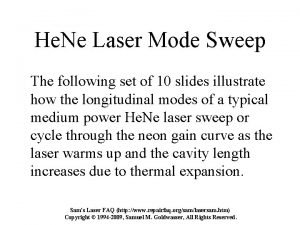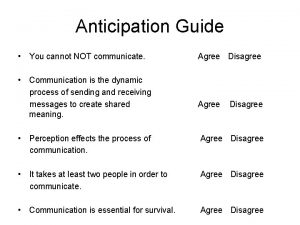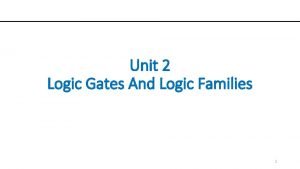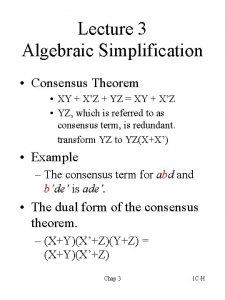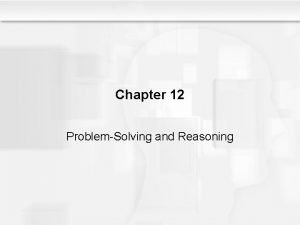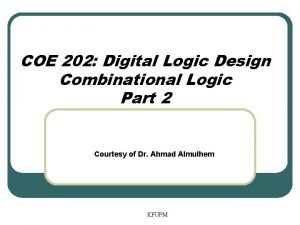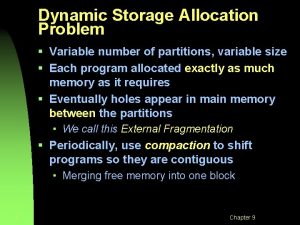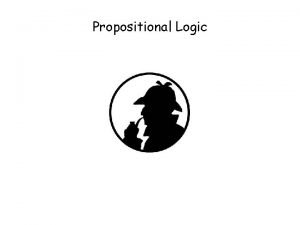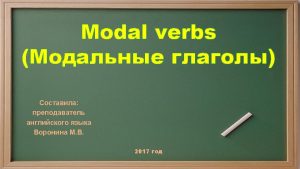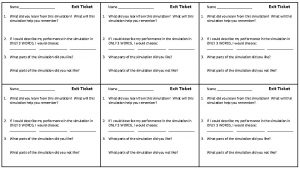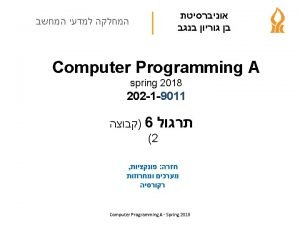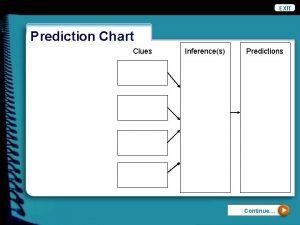FAQ Exit Vi Using q Can NOT exit











































- Slides: 43

FAQ: Exit Vi Using : q Can NOT exit with “: q” if you have not use “: w” to write changes.

FAQ: Linux Users • Install two operating systems (i. e. , Windows and Linux on your PC) • Virtual Machines. (e. g. , Virtual. Box; VMWare) • Virtual. Box is running on Windows; Install Linux (e. g. , Ubuntu in Virtual. Box)

Learn More About g++: info g++

COMP 2710 Software Construction C++ Basics Dr. Xiao Qin Auburn University http: //www. eng. auburn. edu/~xqin@auburn. edu These slides are adapted from notes by Dr. Walter Savitch (UCSD)

C++ Variables • C++ Identifiers – – – Keywords/reserved words vs. Identifiers Must start with a letter or the underscore symbol The rest must be letters, digits, or the underscore symbol Case-sensitivity and validity of identifiers Meaningful names! (see also Page 13) • Variables – A memory location to store data for a program – Must declare all data before use in program 1 -5

C++ Variables - Examples • X, x, abc, _yyy, TBL 123, sum, count, RATE • Which identifiers are poor choices for us? • Why? • 76, 9 B, %Percent, time-2, firstprog. c, main. cpp • Which identifier will be rejected by the compiler? • Why? 1 -6

C++ Variables - Examples (cont. ) • Are STUDENT, student, and Student three distinct identifiers? • Why? 1 -7

Keywords • Reserved Words • Predefined meaning in C++ • Example: – – – short, long, char, true, false, if, else, for, while, class, private, public, typedef, static, sizeof, new, delete, • See Appendix 1 for a complete list of keywords. 1 -8

Declare a Variable • A variable must be declared before it is used! • Tell the compiler what kind of data (i. e. , data type) will be stored in the variable • See what will happen when you compile a C++ program where a variable is not declared. 1 -9

Data Types: Display 1. 2 Simple Types (1 of 2) Copyright © 2008 Pearson Addison-Wesley. All rights reserved. 1 -10

Data Types: Display 1. 2 Simple Types (2 of 2) Unsigned Version: unsigned int, unsigned long Copyright © 2008 Pearson Addison-Wesley. All rights reserved. 1 -11

Assigning Data • Initializing data in declaration statement – Results "undefined" if you don’t! • int my. Value = 0; • int count = 0, distance = 15, factor = 1; • Assigning data during execution – Lvalues (left-side) & Rvalues (right-side) • Lvalues must be variables • Rvalues can be any expression • Example: distance = rate * time; Lvalue: "distance" Rvalue: "rate * time" Copyright © 2008 Pearson Addison-Wesley. All rights reserved. 1 -12

Assigning Data: Tips • All the initial values can be assigned in one function • An assignment statement can be an expression on the right-hand side. Not Recommended. my. Distance = (your. Distance = 15); //not recommended my. Distance = your. Distance = 15; //not recommended • Pitfall: Uninitialized Variables desired. Number = minimum. Number + 10; //uninitialized variables? • How to Guard your Input Parameters? – Check input parameters before using them 1 -13

Assigning Data: Shorthand Notations • Display, page 14 Variable Operator = Expression Copyright © 2008 Pearson Addison-Wesley. All rights reserved. 1 -14

Data Assignment Rules • Compatibility of Data Assignments – Type mismatches • General Rule: Cannot place value of one type into variable of another type – int. Var = 2. 99; // 2 is assigned to int. Var! • Only integer part "fits", so that’s all that goes • Called "implicit" or "automatic type conversion" – You can assign int values to double variables • double. Variable; • double. Variable = 2; – Literals • 2, 5. 75, "Z", "Hello World" • Considered "constants": can’t change in program Copyright © 2008 Pearson Addison-Wesley. All rights reserved. 1 -15

Literal Data • Literals: Names for specific values – Examples: • • 2 5. 75 "Z" "Hello World" // Literal constant int // Literal constant double // Literal constant char // Literal constant string • Cannot change values during execution • Called "literals" because you "literally typed" them in your program! Copyright © 2008 Pearson Addison-Wesley. All rights reserved. 1 -16

Escape Sequences • "Extend" character set • Backslash, preceding a character – Instructs compiler: a special "escape character" is coming – Following character treated as "escape sequence char" – Display 1. 3 next slide Copyright © 2008 Pearson Addison-Wesley. All rights reserved. 1 -17

Display 1. 3 Some Escape Sequences (1 of 2) Copyright © 2008 Pearson Addison-Wesley. All rights reserved. 1 -18

Display 1. 3 Some Escape Sequences (2 of 2) Copyright © 2008 Pearson Addison-Wesley. All rights reserved. 1 -19

Constants • Naming your constants – Literal constants are "OK", but provide little meaning • e. g. , seeing 24 in a pgm, tells nothing about what it represents • Use named constants instead – Meaningful name to represent data const int NUMBER_OF_STUDENTS = 24; const int BRANCH_COUNT = 10, WINDOW_COUNT = 10; //not recommended, a separate line is clearer. • Called a "declared constant" or "named constant" • Now use it’s name wherever needed in program • Added benefit: changes to value result in one fix 1 -20

Display 1. 4 Named Constant 1 -21

Summary • C++ is case-sensitive • Use meaningful names – For variables and constants • Variables must be declared before use – Should also be initialized • Use care in numeric manipulation – Precision, parentheses, order of operations • #include C++ libraries as needed Copyright © 2008 Pearson Addison-Wesley. All rights reserved. 1 -22

Arithmetic Precision • Precision of Calculations – VERY important consideration! • Expressions in C++ might not evaluate as you’d "expect"! – "Highest-order operand" determines type of arithmetic "precision" performed – Common pitfall! Copyright © 2008 Pearson Addison-Wesley. All rights reserved. 1 -23

Arithmetic Precision Examples • Examples: – 17 / 5 evaluates to 3 in C++! • Both operands are integers • Integer division is performed! – 17. 0 / 5 equals 3. 4 in C++! • Highest-order operand is "double type" • Double "precision" division is performed! – int. Var 1 =1, int. Var 2=2; int. Var 1 / int. Var 2; • Performs integer division! • Result: 0! Copyright © 2008 Pearson Addison-Wesley. All rights reserved. 1 -24

Individual Arithmetic Precision • Calculations done "one-by-one" – 1 / 2 / 3. 0 / 4 performs 3 separate divisions. • First 1 / 2 equals 0 • Then 0 / 3. 0 equals 0. 0 • Then 0. 0 / 4 equals 0. 0! • So not necessarily sufficient to change just "one operand" in a large expression – Must keep in mind all individual calculations that will be performed during evaluation! Copyright © 2008 Pearson Addison-Wesley. All rights reserved. 1 -25

Type Casting • Casting for Variables – Can add ". 0" to literals to force precision arithmetic, but what about variables? • We can’t use "my. Int. 0"! – static_cast<double>int. Var – Explicitly "casts" or "converts" int. Var to double type • Result of conversion is then used • Example expression: double. Var = static_cast<double>int. Var 1 / int. Var 2; – Casting forces double-precision division to take place among two integer variables! Copyright © 2008 Pearson Addison-Wesley. All rights reserved. 1 -26

Type Casting • Two types – Implicit—also called "Automatic" • Done FOR you, automatically 17 / 5. 5 This expression causes an "implicit type cast" to take place, casting the 17 17. 0 – Explicit type conversion • Programmer specifies conversion with cast operator (double)17 / 5. 5 Same expression as above, using explicit cast (double)my. Int / my. Double More typical use; cast operator on variable Copyright © 2008 Pearson Addison-Wesley. All rights reserved. 1 -27

Shorthand Operators • Increment & Decrement Operators – Just short-hand notation – Increment operator, ++ int. Var++; is equivalent to int. Var = int. Var + 1; – Decrement operator, -int. Var--; is equivalent to int. Var = int. Var – 1; Copyright © 2008 Pearson Addison-Wesley. All rights reserved. 1 -28

Shorthand Operators: Two Options • Post-Increment int. Var++ – Uses current value of variable, THEN increments it • Pre-Increment ++int. Var – Increments variable first, THEN uses new value • "Use" is defined as whatever "context" variable is currently in • No difference if "alone" in statement: int. Var++; and ++int. Var; identical result Copyright © 2008 Pearson Addison-Wesley. All rights reserved. 1 -29

Post-Increment in Action • Post-Increment in Expressions: int n = 2, value. Produced; value. Produced = 2 * (n++); cout << value. Produced << endl; cout << n << endl; – This code segment produces the output: 4 3 – Since post-increment was used Copyright © 2008 Pearson Addison-Wesley. All rights reserved. 1 -30

Pre-Increment in Action • Now using Pre-increment: int n = 2, value. Produced; value. Produced = 2 * (++n); cout << value. Produced << endl; cout << n << endl; – This code segment produces the output: 6 3 – Because pre-increment was used Copyright © 2008 Pearson Addison-Wesley. All rights reserved. 1 -31

Console Input/Output • I/O objects cin, cout, cerr • Defined in the C++ library called <iostream> • Must have these lines (called preprocessor directives) near start of file: – #include <iostream> using namespace std; – Tells C++ to use appropriate library so we can use the I/O objects cin, cout, cerr Copyright © 2008 Pearson Addison-Wesley. All rights reserved. 1 -32

Console Output • What can be outputted? – Any data can be outputted to display screen • • Variables Constants Literals Expressions (which can include all of above) – cout << number. Of. Games << " games played. "; 2 values are outputted: "value" of variable number. Of. Games, literal string " games played. " • Cascading: multiple values in one cout Copyright © 2008 Pearson Addison-Wesley. All rights reserved. 1 -33

Separating Lines of Output • New lines in output – Recall: "n" is escape sequence for the char "newline" • A second method: object endl • Examples: cout << "Hello Worldn"; • Sends string "Hello World" to display, & escape sequence "n", skipping to next line cout << "Hello World" << endl; • Same result as above Copyright © 2008 Pearson Addison-Wesley. All rights reserved. 1 -34

Formatting Output • Formatting numeric values for output – Values may not display as you’d expect! cout << "The price is $" << price << endl; • If price (declared double) has value 78. 5, you might get: – The price is $78. 500000 or: – The price is $78. 5 • We must explicitly tell C++ how to output numbers in our programs! Copyright © 2008 Pearson Addison-Wesley. All rights reserved. 1 -35

Formatting Numbers • "Magic Formula" to force decimal sizes: cout. setf(ios: : fixed); cout. setf(ios: : showpoint); cout. precision(2); • These stmts force all future cout’ed values: – To have exactly two digits after the decimal place – Example: cout << "The price is $" << price << endl; • Now results in the following: The price is $78. 50 • Can modify precision "as you go" as well! Copyright © 2008 Pearson Addison-Wesley. All rights reserved. 1 -36

Error Output • Output with cerr – cerr works same as cout – Provides mechanism for distinguishing between regular output and error output • Re-direct output streams – Most systems allow cout and cerr to be "redirected" to other devices • e. g. , line printer, output file, error console, etc. Copyright © 2008 Pearson Addison-Wesley. All rights reserved. 1 -37

Input Using cin • cin for input, cout for output • Differences: – ">>" (extraction operator) points opposite • Think of it as "pointing toward where the data goes" – Object name "cin" used instead of "cout" – No literals allowed for cin • Must input "to a variable" • cin >> num; – Waits on-screen for keyboard entry – Value entered at keyboard is "assigned" to num Copyright © 2008 Pearson Addison-Wesley. All rights reserved. 1 -38

Prompting for Input: cin and cout • Always "prompt" user for input cout << "Enter number of dragons: "; cin >> num. Of. Dragons; – Note no "n" in cout. Prompt "waits" on same line for keyboard input as follows: Enter number of dragons: ____ • Underscore above denotes where keyboard entry is made • Every cin should have cout prompt – Maximizes user-friendly input/output Copyright © 2008 Pearson Addison-Wesley. All rights reserved. 1 -39

Program Style • Bottom-line: Make programs easy to read and modify • Comments, two methods: – // Two slashes indicate entire line is to be ignored – /*Delimiters indicates everything between is ignored*/ – Both methods commonly used • Identifier naming – ALL_CAPS for constants – lower. To. Upper for variables – Most important: MEANINGFUL NAMES! Copyright © 2008 Pearson Addison-Wesley. All rights reserved. 1 -40

Libraries • C++ Standard Libraries • #include <Library_Name> – Directive to "add" contents of library file to your program – Called "preprocessor directive" • Executes before compiler, and simply "copies" library file into your program file • C++ has many libraries – Input/output, math, strings, etc. Copyright © 2008 Pearson Addison-Wesley. All rights reserved. 1 -41

Namespaces • Namespaces defined: – Collection of name definitions • For now: interested in namespace "std" – Has all standard library definitions we need • Examples: #include <iostream> using namespace std; • Includes entire standard library of name definitions • #include <iostream>using std: : cin; using std: : cout; • Can specify just the objects we want Copyright © 2008 Pearson Addison-Wesley. All rights reserved. 1 -42

Summary • Object cout – Used for console output • Object cin – Used for console input • Object cerr – Used for error messages • Use comments to aid understanding of your program – Do not overcomment Copyright © 2008 Pearson Addison-Wesley. All rights reserved. 1 -43
 Define means of egress
Define means of egress Exit exit access and exit discharge
Exit exit access and exit discharge You cant manage what you dont measure
You cant manage what you dont measure Faq 9
Faq 9 Condeco software tesco
Condeco software tesco Pipeline control room software
Pipeline control room software Faq guide for college or work
Faq guide for college or work Escala de depresión de yesavage
Escala de depresión de yesavage Copie en ligne
Copie en ligne Ariba faq
Ariba faq Worx landroid front wheel replacement
Worx landroid front wheel replacement Sam's sweep
Sam's sweep Ntu faq
Ntu faq Aka.ms/recoverykey/faq
Aka.ms/recoverykey/faq Uncontrolled, lacking in restraint
Uncontrolled, lacking in restraint You cannot not communicate
You cannot not communicate Using system using system.collections.generic
Using system using system.collections.generic Defrost using internal heat is accomplished using
Defrost using internal heat is accomplished using Boolean expression for nor gate
Boolean expression for nor gate Literary devices simile
Literary devices simile Comparing two things literary device
Comparing two things literary device Refusal skill meaning
Refusal skill meaning Consensus theorem definition
Consensus theorem definition Popcorn heat transfer lab
Popcorn heat transfer lab The radiation problem can be solved using
The radiation problem can be solved using Size
Size Why can we represent light rays using a ruler
Why can we represent light rays using a ruler Diffraction ocean waves
Diffraction ocean waves Coe 202
Coe 202 You can run pig in batch mode using
You can run pig in batch mode using What is dynamic storage allocation problem in os
What is dynamic storage allocation problem in os This chapter shows how vectors can be added using
This chapter shows how vectors can be added using Formula for elasticity of supply
Formula for elasticity of supply If you are not confused you're not paying attention
If you are not confused you're not paying attention Informal and casual
Informal and casual Attention is not not explanation
Attention is not not explanation Not too narrow not too deep
Not too narrow not too deep If p, then q
If p, then q Just right scale
Just right scale Edna st vincent millay love is not all
Edna st vincent millay love is not all Eyes that see and ears that hear
Eyes that see and ears that hear Sit pp
Sit pp We will not be moved you're standing with us
We will not be moved you're standing with us Not a rustling leaf, not a bird in flight
Not a rustling leaf, not a bird in flight











